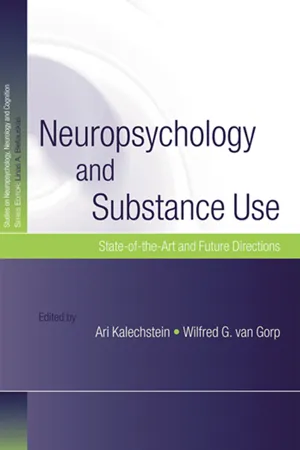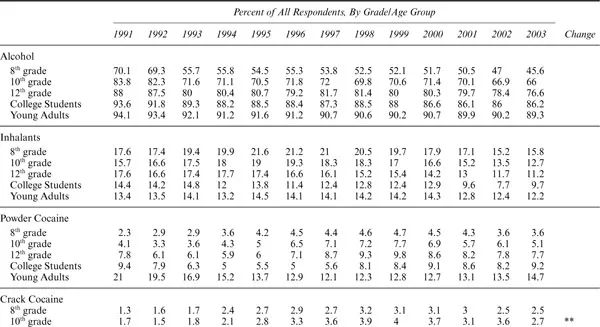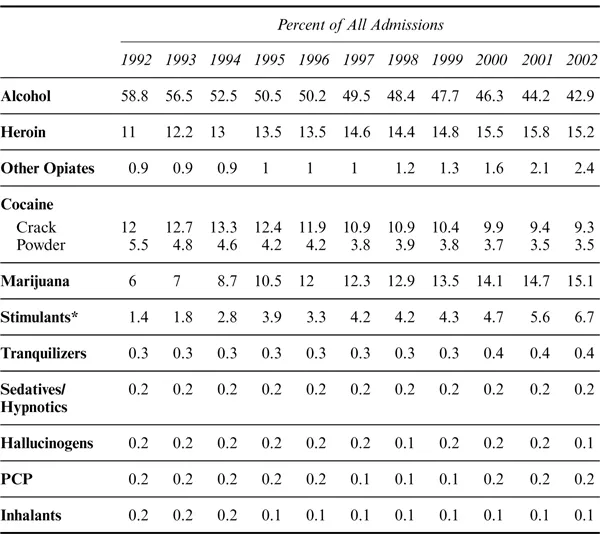![]()
1 Substance Abuse Epidemiology in the United States: A Review of the Indicator Data
Jane C. Maxwell, Beth A. Rutowski, and Richard A. Rawson
Ask any seven people in the United States “What is the worst drug problem in America in 2004?” and you are likely to get seven different answers. For the high school teacher in Pennsylvania, it might appear that marijuana use is rampant among his/her students; for the emergency room doctor in Hawaii, it most certainly is methamphetamine; for the policeman in Washington, DC, “crack” is king; for the parent on an Indian reservation in Arizona, the big concern may be gasoline sniffing; for the primary care physician in Kentucky, OxyContin appears to be an overnight epidemic; the coroner in Baltimore will certainly maintain that heroin is the biggest killer in that city; and, of course, as any highway patrol officer will report across the USA, alcohol is the drug that creates the most problems and costs the most lives.
If you were the Director of the White House Office of National Drug Control Policy, how would you decide which of these problems represented the top priority for spending the limited resources available to prevent and treat substance abuse problems in the USA? In an attempt to answer this question, a set of data collection systems has been established to quantify shifts in drug use patterns in the USA. While the use of multiple data collection systems leads to some inconsistencies in trend information due to the fact that each data system sees the problem from a different point of view, an overview of drug use trends can be constructed by considering a number of different indicators, including both quantitative and qualitative sources.
This chapter evaluates the data from a number of sources to identify trends and patterns of use of alcohol and illicit drugs. The data are arrayed to put together a somewhat cohesive picture of who tends to use which drugs, the trends in use, and the medical and psychological (including neuropsychological) consequences of substance use. The following data sources are discussed in detail in each drug section, and will be referred to hereafter by their abbreviated acronyms.
The Monitoring the Future Survey (MTF) is conducted by the University of Michigan’s Institute for Social Research and is funded by the National Institute on Drug Abuse (NIDA). It tracks illicit drug use and attitudes toward drugs by eighth, tenth, and twelfth graders, as well as college students, their age peers not in college, young adult high school graduates through to age 30, and high school graduates aged 35, 40, and 45. The data presented in this chapter cover eighth, tenth, and twelfth graders, college students, and young adults aged 19–28. The MTF reports can be accessed at http://monitoringthefuture.org.
The National Survey on Drug Use and Health (NSDUH), formerly called the National Household Survey on Drug Abuse (NHSDA), is conducted by the Office of Applied Studies of the Substance Abuse and Mental Health Services Administration. It collects information on the prevalence, patterns, and consequences of alcohol, tobacco, and illegal drug use and abuse in the US civilian non-institutionalized population, ages 12 and older. In 2003, a total of 67,784 individuals were sampled in this survey, which is representative of the US general population. The survey reports can be found at http://oas.samhsa.gov/nhsda.htm.
The Drug Abuse Warning Network (DAWN) comprises two components: emergency department (ED) data and mortality data from medical examiners (ME). The ED component provides statistical estimates of drug-related visits to emergency departments for 21 metropolitan areas as well as for the nation. Reasons for visits can include drug abuse and misuse, adverse reactions, accidental ingestion, overmedication, malicious poisoning, suicide attempts, underage drinking, and patients seeking detoxification or drug abuse treatment. The ME component collects data on deaths involving drug abuse (drug-induced or drug-related) that were identified and submitted by participating medical examiners in approximately 40 metropolitan areas across the United States. Unlike the ED component, the ME component is not a sample and it does not provide statistical estimates for the nation as a whole; it simply collects data voluntarily reported by interested medical examiners. DAWN is conducted by the Office of Applied Studies of the Substance Abuse and Mental Health Services Administration. The reports can be found at http://dawninfo.samhsa.gov.
The Treatment Episode Data Set (TEDS) collects information on individuals admitted to substance abuse treatment facilities that are licensed or certified by the 50 state substance abuse agencies. Reporting facilities tend to be those that receive state alcohol and/or drug agency funds, including Federal Block Grant funds. In 2002, over 1.9 million treatment admissions were reported. TEDS is conducted by the Office of Applied Studies of the Substance Abuse and Mental Health Services Administration. The reports can be found at http://oas.samhsa.gov/dasis.htm#teds2.
The Arrestee Drug Abuse Monitoring Program (ADAM) measures the extent of drug use in the high-risk population of people who have been arrested and booked or detained. The 2003 data were collected through probability-based sampling of male arrestees in adult facilities in 39 participating counties (weighted sample of 180,455) and purposive sampling of female arrestees in 25 counties (sample of 3664 females). Information comes from interviews and urine analyses obtained voluntarily and recorded con-fidentially in booking facilities, usually on the day of arrest and always within 48 hours of arrest. In addition to testing for several drugs, in 2003 data were included for arrestees testing positive for recent alcohol consumption. ADAM was funded by the National Institute of Justice but was discontinued after 2003. The reports are available at http://www.ojp.usdoj.gov/nij/adam/welcome.html.
The National Forensic Laboratory Information System (NFLIS), sponsored by the Drug Enforcement Administration (DEA), is a program that systematically collects results from toxicological analyses conducted by state and local forensic laboratories on substances seized in law enforcement operations. The NFLIS, which was begun in 1997, now collects data from nearly 200 laboratories in 35 states and 55 localities. In 2003, a total of 1,596,780 items were reported (Drug Enforcement Administration, 2004b). The NFLIS reports are available at http://www.deadiversion.usdoj.gov/nflis/index.html. The authors downloaded most of the data in this chapter from the NFLIS online system.
The Community Epidemiology Work Group (CEWG) is sponsored by the National Institute on Drug Abuse (NIDA). The CEWG is composed of 21 researchers from across the nation. They meet twice per year to report on drug abuse patterns and trends and emerging problems in their local areas. Members use quantitative statistics and qualitative techniques such as focus groups and key informant interviews to monitor drug trends. The full reports of the CEWG can be accessed at http://www.nida.nih.gov/about/organization/cewg/Reports.html.
The Drug Enforcement Administration (DEA) reports the price and purity of drugs in various geographic regions of the country. The reports are available at http://www.usdoj.gov/dea/statistics.html.
Alcohol
Alcohol is the most widely used drug, with an economic cost in terms of health care, lost productivity, and criminal justice costs of $166.5 billion to American society in 1995, as compared to an economic cost of $109.8 billion for drug abuse (Harwood et al., 1998). Binge and heavy drinking remains a problem, and alcohol is often misused in combination with other drugs.
According to results from the 2003 MTF, there was little change in alcohol use among survey participants in the 12 months since the last survey was administered (Exhibit 1.1). Twelfth graders were the only group of students who showed further decline in 30-day prevalence of drinking (from 48.6% in 2002 to 47.5% in 2003). Occurrences of heavy drinking (which is defined as consumption of five or more drinks in a row in the past two weeks) continued to decrease slightly (although not significantly) in all three grades, and the prevalence of daily alcohol use remained low in all three grades, decreasing slightly among tenth graders (1.8% to 1.5%) and twelfth graders (3.5% to3.2%). In terms of long-term trends in lifetime alcohol use, 70.1% of eighth graders, 83.8% of tenth graders, 88.0% of twelfth graders, 93.6% of college students, and 94.1% of young adults reported any alcohol use in 1991. Twelve years later, in 2003, these rates had fallen to 45.6% among eighth graders,66.0% among tenth graders, 76.6% among twelfth graders, 86.2% among college students, and 89.3% among young adults. Lifetime, past year, and past month use by girls aged 12–17 now equals or surpasses that of boys (Johnston et al., 2004a, 2004b).
Exhibit 1.1 Lifetime prevalence of drugs from the Monitoring the Future Surveys: 1991–2003
Levels of significance of difference between the two most recent years: * =0.05; ** =0.01, *** =0.001.
Young Adult category includes individuals aged 19–28.
(...) Data not available.
Source: Monitoring the Future Survey, NIDA.
The 2003 NSDUH reported that 50% or an estimated 119 million Americans aged 12 or older consumed alcohol in the 30 days preceding their survey. Approximately 54 million (22.6%) individuals binged (defined as consumption of five or more drinks on the same occasion at least once in the past 30 days) at least once in the 30 days prior to the survey, and 16 million (6.8%) drank heavily (defined as consumption of five or more drinks on the same occasion on at least five different days in the past 30 days). Young adults aged 18–25 were most likely to report patterns of both binge and heavy drinking in 2003. Binge and heavy alcohol use rates decreased faster with increasing age than did rates of past month alcohol use.
Of all racial/ethnic groups, Whites were most likely to report current use of alcohol in 2003 (54.4%), followed by American Indians/Alaska Natives (42.0%) and Hispanics (41.5%), and then Blacks (37.9%). In terms of geographic differences in self-reported alcohol use, the rate of past month alcohol use among persons aged 12 and older was highest in large metropolitan areas (53.3%), as compared to small metropolitan areas (48.9%) and nonmetropolitan areas (42.1%).
With regard to underage alcohol use, nearly 11 million persons aged 12–20 consumed alcohol in the 30 days prior to their survey, which represented 29% of the age group. Of these individuals, 7.2 million (19.2%) binge drank and 2.3 million (6.1%) drank heavily. The prevalence of current alcohol use among adolescents increased with increasing age, from 2.9% of 12-year-olds to 59.6% of 20-year-olds.
Girls aged 12–17 reported higher rates of lifetime, past year, and past month use of alcohol (43.9%, 36.5%, 18.3%) than their male peers (41.9%, 32.1%,17.1%), although boys reported higher rates of binge and heavy alcohol use. Among those aged 18–25, males reported higher lifetime, past year, and past month use than females, as well as higher rates of binge and heavy alcohol use.
In 2003, current self-reported alcohol use was strongly associated with other substance use, including tobacco and illicit drugs. Among the 16.1 million heavy drinkers aged 12 and older, 32.5% were also current illicit drug users. Moreover, 61.7% of heavy drinkers smoked cigarettes in the past month. Smokeless tobacco and cigar use were higher among heavy drinkers than among nonbinge drinkers and nondrinkers.
The number of new alcohol users rose steadily during the 1990s, from 2.9 million new alcohol users in 1990 to 5.3 million in 2001. Much of this increase can be accounted for by initiation of use among young persons under the age of 21. The number of new adolescent users nearly doubled in the past decade, from 2.0 million in 1990 to 3.8 million in 2001. Of the estimated 21.6 million Americans aged 12 or older who were classified with substance dependence or abuse in 2003 (9.1% of the total population aged 12 or older), 14.8 million were dependent upon or abused alcohol, but not illicit drugs. In 2003, 1.1 million individuals received alcohol treatment (SAMHSA, 2004d, 2004e).
The DAWN ED system reported that the rate of mentions of alcohol in combination with other drugs had increased significantly from 71.7 per 100,000 in 1995 to 80.8 per 100,000 in 2002. The increase was significant for males, for all persons aged 18–25, and for those aged 35 and older. Of the 207,395 cases seen, 61% were male, 55% White, 26% Black, and 10% Hispanic. Fifty-five percent were aged 35 or older. Forty-one of the cases reported their motive for seeking emergency department care was dependence, while 25% reported a suicide attempt, and 21% reported psychic effects. The reason for the contact for 35% was an overdose, with 23% seeking detoxification. Fifty-five percent of the cases were admitted to hospital for further care (SAMHSA, 2003).
The proportion of TEDS treatment admissions with a primary problem of alcohol dropped from 59% in 1992 to 43% in 2002 (Exhibit 1.2). In 2002, there were 807,939 alcohol admissions. Of these admissions, 45% reported that they also had secondary problems with other drugs. Clients who were alcohol-only admissions in 2002 were likely to be male (76%), White (71%), and with an average age of 39 years. Those with a primary alcohol problem and a secondary drug problem were also more likely to be male (74%), less likely than alcohol-only clients to be White (59%), and to be younger (average age 34 years). Forty percent of alcohol-only admissions and 34% of alcohol and drug admissions were referred to treatment from criminal justice agencies (SAMHSA, 2004a). Marijuana was the most frequently reported second problem drug (24%), followed by cocaine (19%; SAMHSA, 2004b).
Exhibit 1.2 US admissions to treatment by primary drug of abuse: 1992–2002
*Includes methamphetamine, other amphetamines, and other stimulants. Source: Treatment Episode Data Set, SAMHSA.
The DAWN ME component includes data on two categories of deaths: drug-induced and drug-related. One to six drugs can be mentioned in conjunction with a reportable case. To facilitate the interpretation of DAWN ME findings for each participating metropolitan area, deaths involving only one drug (“single-drug” deaths) are differentiated from those involving more (“multiple-drug” deaths). Alcohol is frequently mentioned in combination with other commonly reported drugs, such as cocaine, heroin/morphine, and narcotic analgesics. It is important to note that the number of cases involving these combinations varies across participating metropolitan areas, and many other drug combinations are reported. In 19 of the 31 metropolitan areas in 2002, alcohol (in combination with at least one other drug) was one of the three most frequently mentioned drugs in reported cases (SAMHSA, 2004c).
According to ADAM data collected in 2003, 10% of adult male and 86% of adult female arrestees tested positive for recent alcohol consumption. Median past 30-day binge and heavy alcohol use was higher among males than females (48% and 26% respectively for males, compared with 35% and 16% respectively for females; Zhang, 2004).
Inhalants
Inhalants are breathable chemical vapors or gases that produce psychoacti...




